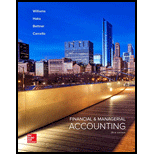
Concept explainers
a.
Prepare a flexible budget of the company and a schedule comparing the actual results with flexible budget amounts.
a.
Explanation of Solution
Budget:
Budget is an effective tool to achieve the financial and operational goals of the business. Budget is the key element of the financial planning and it assists managers to control the business costs. Management should set the budgeted amount at reasonable and achievable levels.
Prepare a flexible budget of the company and a schedule comparing the actual results with flexible budget amounts as follows:
| Company S | |||
| Comparison of Budgeted and Actual Revenue and Expenses | |||
| For the Year Ended December 31 | |||
| Particulars | Flexible Budget ($) (D) | Actual budget ($) (E) | Over (or under) budget ($) |
| Net sales | 10,500,000 | 10,500,000 | - |
| Less: Cost of goods sold | 6,300,000 (1) | 6,180,000 | (120,000) |
| Gross profit on sales (A) | 4,200,000 | 4,320,000 | 120,000 |
| Less: Operating expenses: | |||
| Selling and promotion | 1,071,000 (2) | 1,020,000 | (51,000) |
| Building occupancy | 417,000 (3) | 420,000 | 3,000 |
| Buying | 580,500 (4) | 594,000 | 13,500 |
| Delivery | 195,000 (5) | 183,000 | (12,000) |
| Credit and collection | 93,000 (6) | 90,000 | (3,000) |
| Administrative | 562,500 (7) | 564,000 | 1,500 |
| Total operating expenses (B) | 2,919,000 | 2,871,000 | (48,000) |
| Operating income | 1,281,000 | 1,449,000 | 168,000 |
Table (1)
Working note:
Calculate the cost of goods sold of the flexible budget
Calculate selling and promotion expense of the flexible budget
Calculate building occupancy expense of the flexible budget
Calculate buying expense of the flexible budget
Calculate delivery expense of the flexible budget
Calculate credit card collection expense of the flexible budget
Calculate administrative expense of the flexible budget
b.
Evaluate the company performance in relation to plan reflected in the flexible budget.
b.
Explanation of Solution
Evaluate the company performance in relation to plan reflected in the flexible budget as follows:
Net income in the actual budget is better than the flexible budget, because net income in the actual budget is increased by $168,000 than flexible budget. This result may be attributed by the following factors:
- Company performance in the purchase of merchandise is better in the actual budget.
- The company has incurred very lower expenditure in the actual performance (selling and promotion expense, building occupancy, buying expense, delivery expense, credit collection expense, and administrative expense) than the budgeted.
Want to see more full solutions like this?
Chapter 23 Solutions
Financial & Managerial Accounting
- Can you explain the correct methodology to solve this general accounting problem?arrow_forwardWhat role does assurance boundary definition play in attestation? (a) Standard limits work always (b) Boundaries never matter (c) Engagement scope limits determine verification responsibilities (d) All areas need equal coverage MCQarrow_forwardI need help with this general accounting problem using proper accounting guidelines.arrow_forward
- Please explain the solution to this general accounting problem using the correct accounting principles.arrow_forwardCan you demonstrate the accurate method for solving this financial accounting question?arrow_forwardI am trying to find the accurate solution to this general accounting problem with the correct explanation.arrow_forward

 AccountingAccountingISBN:9781337272094Author:WARREN, Carl S., Reeve, James M., Duchac, Jonathan E.Publisher:Cengage Learning,
AccountingAccountingISBN:9781337272094Author:WARREN, Carl S., Reeve, James M., Duchac, Jonathan E.Publisher:Cengage Learning, Accounting Information SystemsAccountingISBN:9781337619202Author:Hall, James A.Publisher:Cengage Learning,
Accounting Information SystemsAccountingISBN:9781337619202Author:Hall, James A.Publisher:Cengage Learning, Horngren's Cost Accounting: A Managerial Emphasis...AccountingISBN:9780134475585Author:Srikant M. Datar, Madhav V. RajanPublisher:PEARSON
Horngren's Cost Accounting: A Managerial Emphasis...AccountingISBN:9780134475585Author:Srikant M. Datar, Madhav V. RajanPublisher:PEARSON Intermediate AccountingAccountingISBN:9781259722660Author:J. David Spiceland, Mark W. Nelson, Wayne M ThomasPublisher:McGraw-Hill Education
Intermediate AccountingAccountingISBN:9781259722660Author:J. David Spiceland, Mark W. Nelson, Wayne M ThomasPublisher:McGraw-Hill Education Financial and Managerial AccountingAccountingISBN:9781259726705Author:John J Wild, Ken W. Shaw, Barbara Chiappetta Fundamental Accounting PrinciplesPublisher:McGraw-Hill Education
Financial and Managerial AccountingAccountingISBN:9781259726705Author:John J Wild, Ken W. Shaw, Barbara Chiappetta Fundamental Accounting PrinciplesPublisher:McGraw-Hill Education





